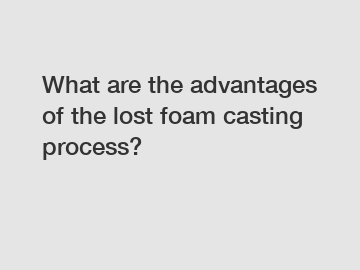What are the advantages of the lost foam casting process?
What are the advantages of the lost foam casting process?
The lost foam casting process, also known as evaporative pattern casting, is a highly versatile and cost-effective method used in the manufacturing industry for producing complex metal components. This process involves creating a foam pattern, coating it with a refractory material, and then pouring molten metal into the coated pattern. As the metal solidifies, the foam pattern evaporates, leaving behind a precisely shaped metal part. This innovative casting technique offers numerous advantages, making it a popular choice for various industries. Let's delve into the advantages of the lost foam casting process:
1. Complex designs and intricate details: One significant advantage of lost foam casting is its ability to produce complex, intricate, and highly detailed parts. As the foam patterns can be shaped and molded with ease, this casting process enables the creation of complex geometries that would be challenging or even impossible to achieve with other traditional casting methods. This makes lost foam casting ideal for applications in industries such as automotive, aerospace, and art.

2. Cost-effective production: Lost foam casting is a highly cost-effective manufacturing process. With the ability to produce complex parts at a reduced cost compared to other casting techniques, this process offers significant savings in both materials and labor. By eliminating the need for complex tooling, sand cores, and assembly processes, manufacturers can streamline their production, reduce scrap rates, and shorten lead times. This efficiency translates into lower overall production costs, making lost foam casting an attractive option for businesses.
3. Improved dimensional accuracy: Lost foam casting provides excellent dimensional accuracy, ensuring that the final product matches the intended specifications. As the foam pattern expands when it is coated with refractory material, it compensates for the expected shrinkage of the metal during solidification. This compensatory expansion eliminates any potential dimensional deviations, resulting in precise and consistent parts. Improved dimensional accuracy reduces the need for costly post-casting machining operations, further enhancing cost savings.
4. Enhanced surface finish: The lost foam casting process is known for its exceptional surface finish quality. By using a foam pattern surface as the mold, the resulting metal part exhibits a smooth surface without the usual marks caused by sand or other mold materials. This eliminates the need for extensive surface finishing operations, saving time and resources. The high-quality surface finish obtained through lost foam casting makes it suitable for applications where aesthetics or low friction are critical factors, such as in decorative pieces or engine components.
In conclusion, the lost foam casting process offers a range of distinct advantages that make it an attractive choice for manufacturers across various industries. With its ability to produce complex designs and intricate details, coupled with cost-effective production and improved dimensional accuracy, lost foam casting has become a go-to method for manufacturing metal components. Additionally, the enhanced surface finish achieved through this process adds further value, saving time and resources. As technology and materials continue to advance, lost foam casting holds much promise for the future of manufacturing, enabling the production of highly intricate and customized parts with greater efficiency and cost-effectiveness.
For more Complete equipment for lost foam casting, Lost foam casting production line manufacturers, How much does the lost foam casting equipmentinformation, please contact us. We will provide professional answers.


